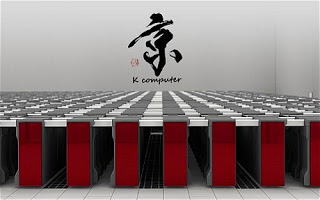The previous fastest machine was the Chinese computer Tianhe-1A, which was clocked at 2.507 petaflops.
The rankings for the world’s fastest computers are kept by a professor of electrical engineering and computer science at the University of Tennessee at Knoxville, one Jack Dongarra.
Jaguar, a Cray supercomputer at the U.S. Department of Energy’s (DOE’s) Oak Ridge National Laboratory, at No. 3 with 1.75 petaflop/s.
Rounding out the Top 10 are Nebulae at China’s National Supercomputing Center in Shenzen (1.27 petaflop/s), Tsubame 2.0 at the Tokyo Institute of Technology (1.19 petaflop/s), Cielo at Los Alamos National Laboratory in New Mexico (1.11 petaflop/s), Pleiades at the NASA Ames Research Center in California (1.09 petaflop/s), Hopper at DOE’s National Energy Research Scientific Computing Center (NERSC) in California (1.054 petaflop/s), Tera 100 at the CEA (Commissariat à l’énergie atomique et aux énergies alternatives) in France (1.05 petaflop/s), and Roadrunner at Los Alamos National Laboratory in New Mexico (1.04 petaflop/s).
The K Supercomputer achieved an extraordinarily high computing efficiency ratio of 93.0%. This achievement is made possible by the K computer’s integration of technologies, including its massive number of CPUs, the interconnectivity that links them together, and the software that is able to bring out the highest performance from the hardware.
When configuration of the K computer is complete in 2012, it is designed to achieve LINPACK performance of 10 petaflops. It will be widely used in a variety of computational science fields where it is expected to contribute to the generation of world-class research results.
The K Computer, built by Fujitsu, currently combines 68544 SPARC64 VIIIfx CPUs, each with eight cores, for a total of 548,352 cores—almost twice as many as any other system in the TOP500.
K’s performance is equivalent to one million linked desktop computers, according to Prof Dongarra, or more than its five closest competitors combined. It consists of 672 cabinets stuffed with circuit-boards, and its creators plan to increase that to 800 in the coming months. It uses enough energy to power nearly 10,000 homes and costs $10 million (£6.2 million) annually to run.
K Supercomputer rack
Two 20 petaflop supercomputers expected in the US in 2012
Oak Ridge National Laboratory in Oak Ridge, Tenn. is building the 20 petaflop Cray Titan for 2012. The $100 million Titan is expected to take on the task of calculating complex energy systems for the U.S. Department of Energy.
The Cray Titan will likely be an XE6 variant with Tesla GPU-equipped blades A new 160,000-square-foot computer facility is planned for the east end of the ORNL campus, but it’s not yet built.
IBM is building a 20 petaflop machine, called Sequoia, at Lawrence Livermore National Laboratory in California in 2012. Sequoia would focus on simulations of nuclear explosions for the purpose of eliminating real-world nuke testing.
If you liked this article, please give it a quick review on ycombinator or StumbleUpon. Thanks

Brian Wang is a Futurist Thought Leader and a popular Science blogger with 1 million readers per month. His blog Nextbigfuture.com is ranked #1 Science News Blog. It covers many disruptive technology and trends including Space, Robotics, Artificial Intelligence, Medicine, Anti-aging Biotechnology, and Nanotechnology.
Known for identifying cutting edge technologies, he is currently a Co-Founder of a startup and fundraiser for high potential early-stage companies. He is the Head of Research for Allocations for deep technology investments and an Angel Investor at Space Angels.
A frequent speaker at corporations, he has been a TEDx speaker, a Singularity University speaker and guest at numerous interviews for radio and podcasts. He is open to public speaking and advising engagements.




